
#uber THREAD 1/ So, as we now know, the Supreme Court has ruled that #Uber drivers are workers & are entitled to pay whenever logged on & prepared to take a passenger. Here's the link to the judgment: supremecourt.uk/cases/docs/uks… #ukemplaw
2/ We all know the basic facts. There are 40,000 Uber drivers across the UK & 2 million people registered on the App (40,000 is a heck of a multiplier when working out the cost of this one!). 

3/ Remember the key facts highlighting in the attachments below. They are crucial to the decision. They concentrate on the constraints placed on the driver - matters of subordination, dependency & limits on their ability to develop business opportunities from passengers. 



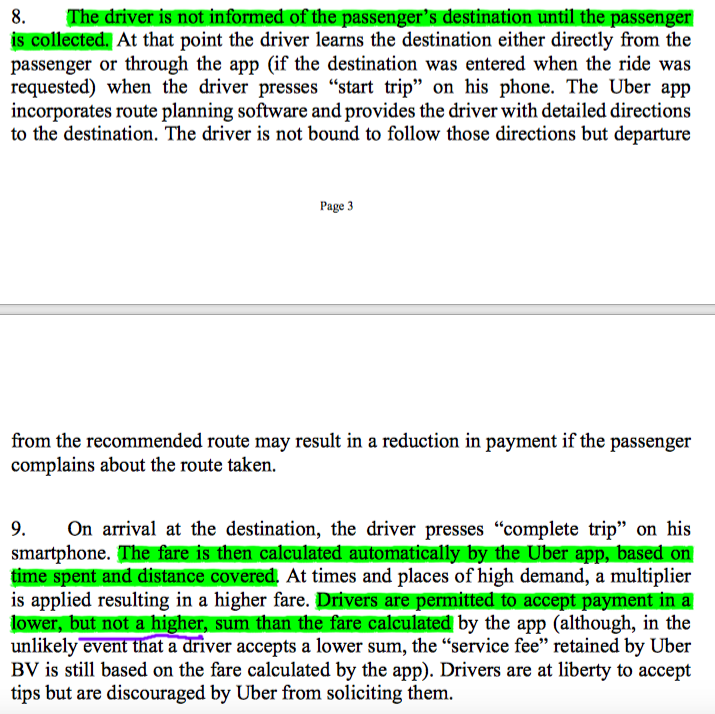

4/ The constraints include limits on information passed to the driver (including their 'client's' contact details), limits on time for acceptance of jobs with that limited info, lack of ability to set higher fares & almost total prohibition on post-job contact with the passenger.
5/ Uber operates various warning and penalty systems that can lead to a driver being automatically logged off the app or removed from the Uber platform altogether. These penalties operate on failure to accept fares & where driver ratings fall below 4.4/5. 
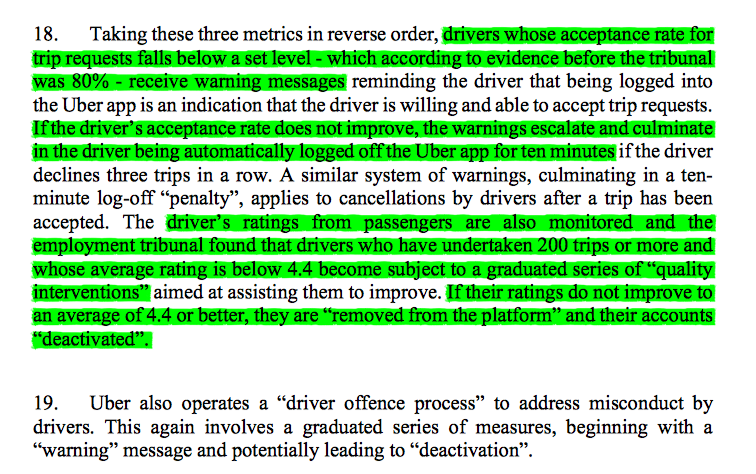
6/ Complaints from passengers aren't handled by the driver, but by Uber London, who will often decide them without even referring to the driver. This sometimes leads to a reduction in a driver's pay. 

7/ After setting out the realities, the Court set out the contractual documentary position. There are 'Partner terms' & a 'Service Agreement' between Uber BV (in the Netherlands) & the driver described as 'an independent company in the business of providing transportation'. 

8/ It is the Service Agreement which seeks to create the fiction of a client relationship between the driver & passenger, and an independent contractor relationship between the driver & Uber. 

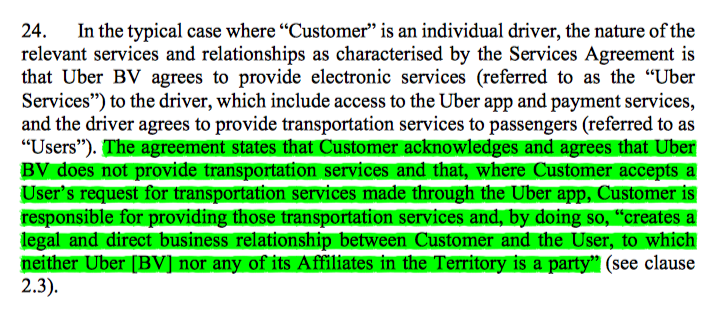

9/ The legal fiction is continued in 'Rider Terms' which passengers click to accept before using the App (hands up anyone who read a single word of the Rider Terms rather than just robotically clicking accept!) 

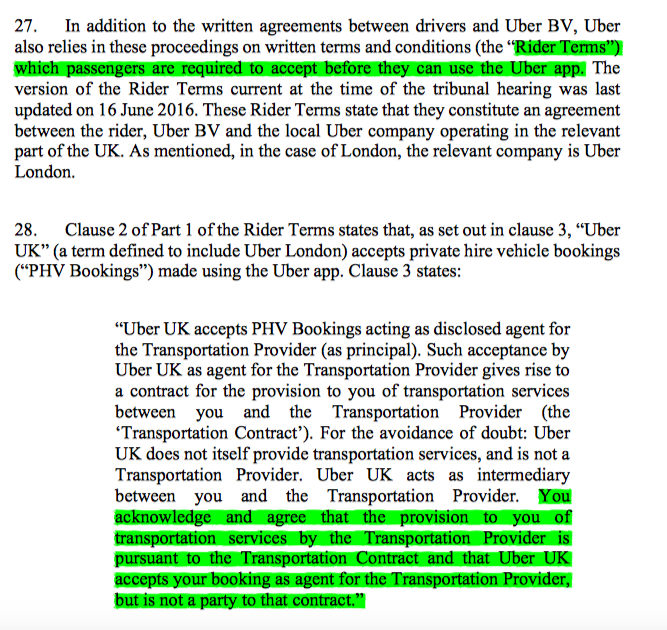

10/ The operator's licence in London is held by Uber London. Under accompanying regs, the operator undertakes to agree or accurately estimate fares when required by a passenger to do so. 


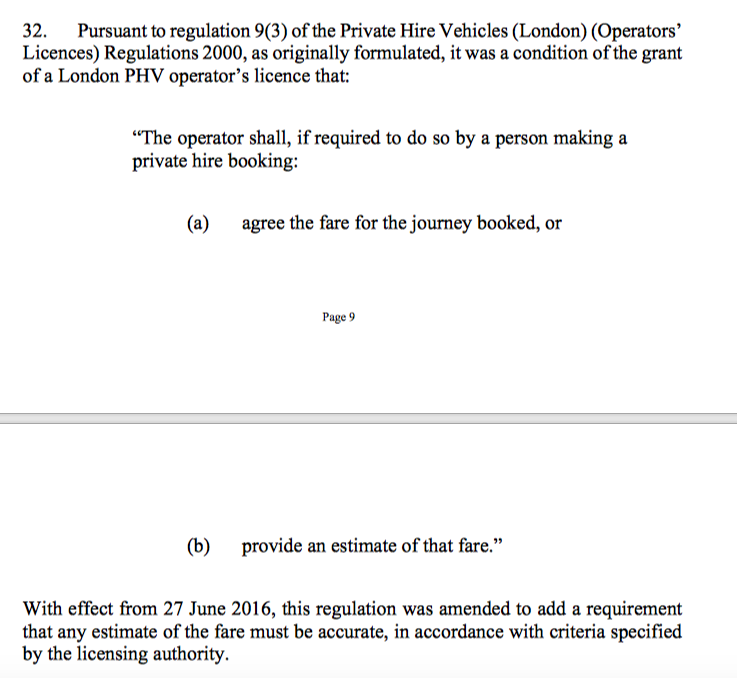
11/ So that's the context in which the Court had to decide whether the drivers were limb (b) workers. For non-lawyers reading this thread, here's the statute's wording and here's a simple explanation of the 3 strands (it's the 1st strand that is in issue in this case): 



12/ The Court noted that Uber's approach to which end of the telescope the Court should 1st look through was that the written agreements should be the primary focus. 
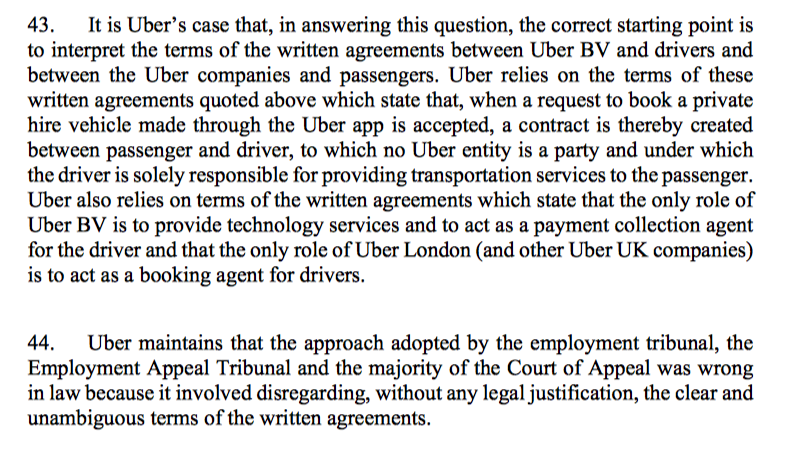
13/ The Court considered that even if that was right & that ordinary contractual & agency principles apply, the lack of any written agreement between Uber London & the drivers was fatal as it meant the terms had to be inferred through conduct rather than documentation. 
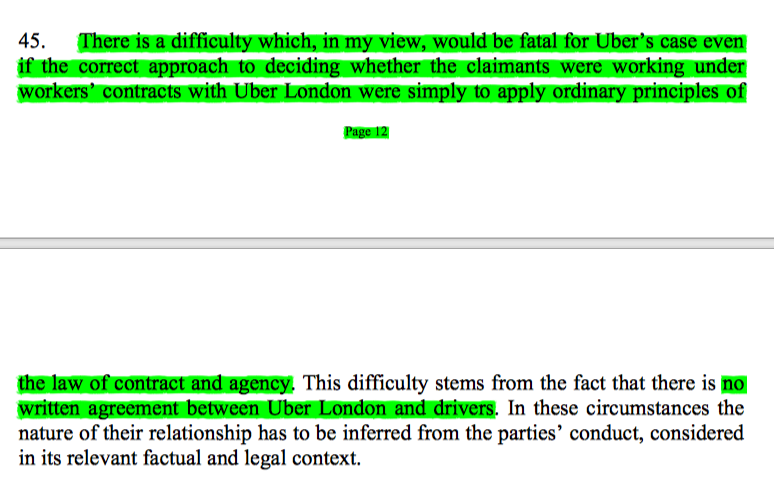
14/ Given that it would be unlawful for a driver to accept passengers without an operator's licence & it had to be assumed nobody would opt to operate illegally, that provided Uber with an intractable problem in showing an independent contractor relationship. 

15/ The Court wasn't convinced by submissions that such a relationship would comply lawfully with the operator licence regs. Nor was the Court convinced by reliance on the Rider Terms to establish an agency relationship in that context - drivers didn't even see those terms. 
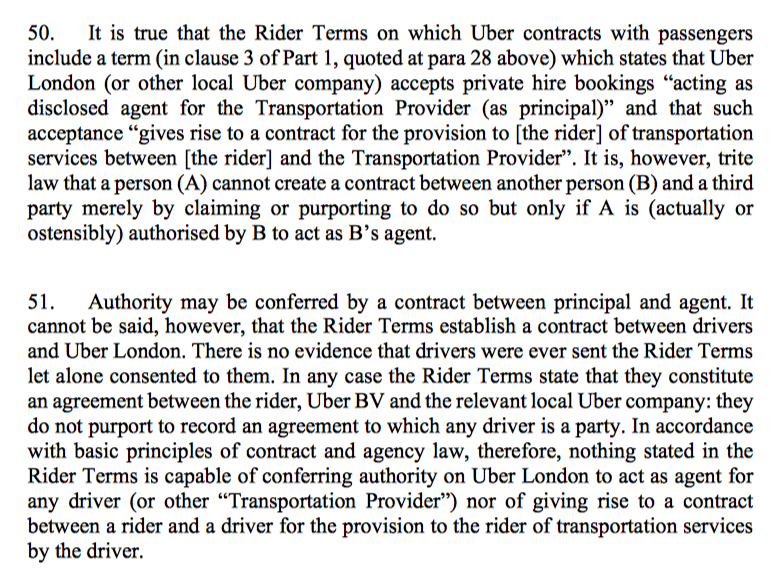
16/ Whilst an agency relationship need not be contractual, there needs to be shown actual or apparent/ostensible authority, and there were no findings of fact made by the ET in this case supportive of that being established (with the Court unimpressed by a contrary submission) 

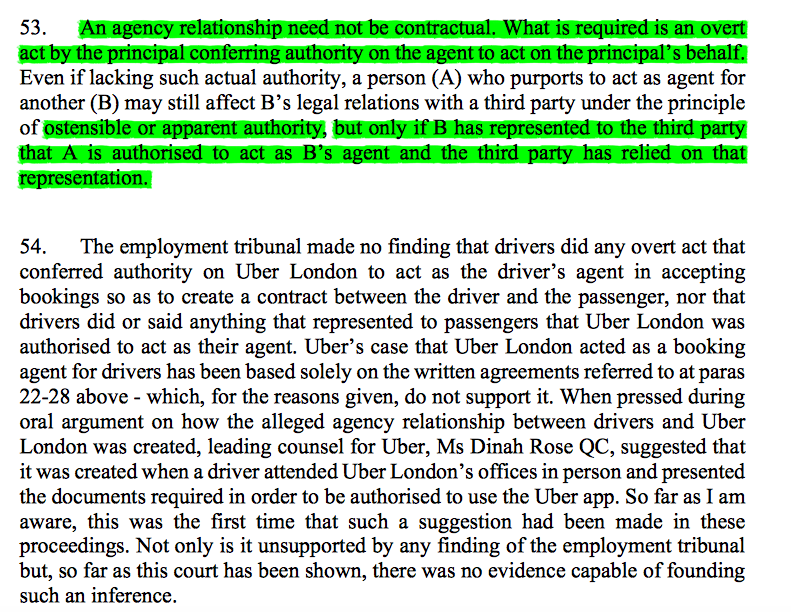

17/ The fatal contractual/agency conclusions would, on their own, have led the Court to conclude that the drivers were limb (b) workers, but given the importance of the case to establishing employment status in the #gigeconomy the Court elaborated further on the law. 

18/ The Court thus moved on to consider Autoclenzer v Belcher (a case which brings a lump to my throat as the Chair at the time of the litigation was my wife's cousin, a truly lovely man who was an early victim of Covid). Autoclenz is key to flexible contractual construction.
19/ As any employment lawyer will tell you, Autoclenz allowed for greater freedom in construing the contractual relationship in a working context, focused on the actual agreement between the parties, not constrained by written terms where inaccurate to that relationship. 
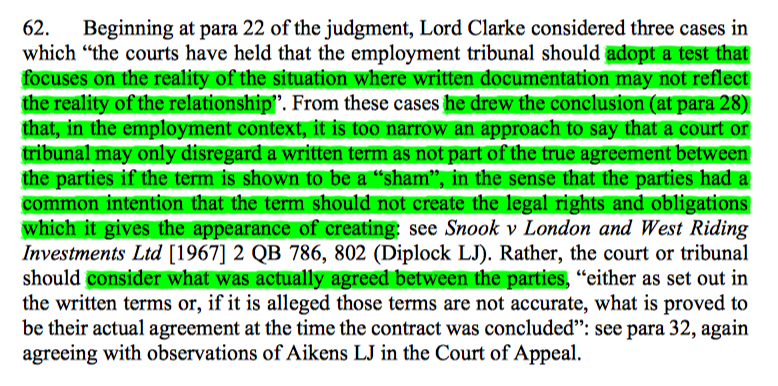
20/ The Supreme Court's approach in Autoclenz recognised the relative bargaining power between company and individual as one of the considerations when trying to glean the actual terms agreed rather than the written terms the individual felt obliged to sign to get the work. 
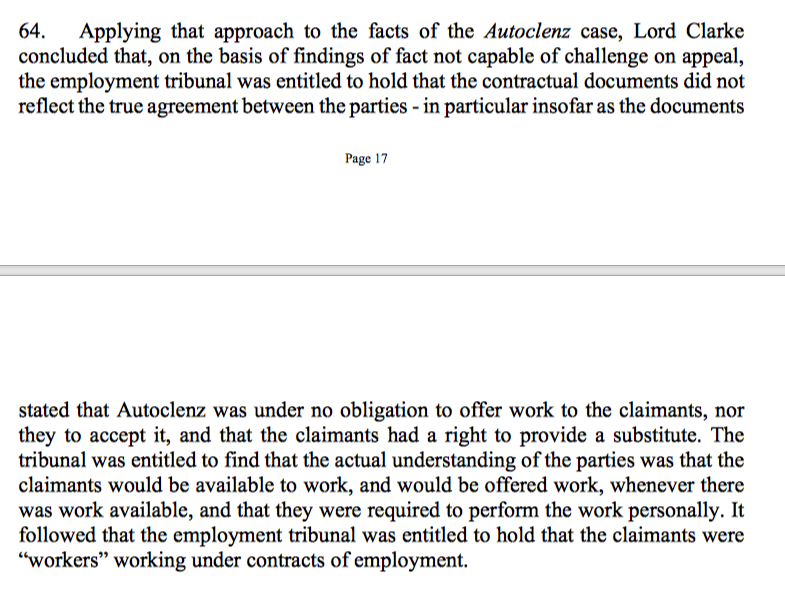
21/ Uber tried to strengthen the company's hand in how Autoclenz should be interpreted, so that the claimant needed to show inconsistency with the written terms before the wider construction techniques applied. The Supreme Court disagreed. 

22/ The Supreme Court in Uber set out a new justification for the Autoclenz conclusions, not set out in that judgment - that the ET's task is to determine whether the legislative test for worker is made out, a question of statutory rather than contractual interpretation. 

23/ A purposive construction of the limb (b) worker provision is that it is protective - opening up the way to a stream of important protective rights for vulnerable workers falling within the classification. Cruelly, the Court relied on Mr Recorder Underhill QC in Byrne Bros: 
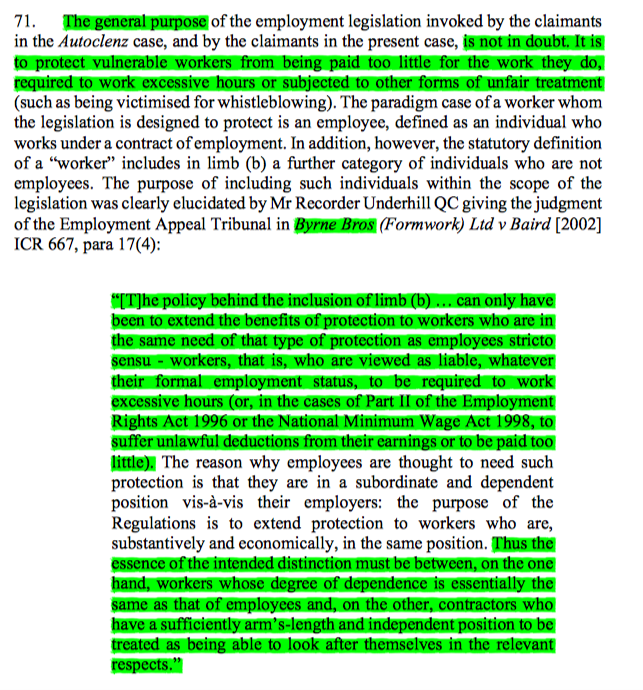
24/ Whilst probably not re-establishing subordination as a freestanding criterion of worker status (& hence not undermining Bates van Winkelhof), the Court noted issues of subordination & dependency are inimical to the vulnerability of workers as against the company. 
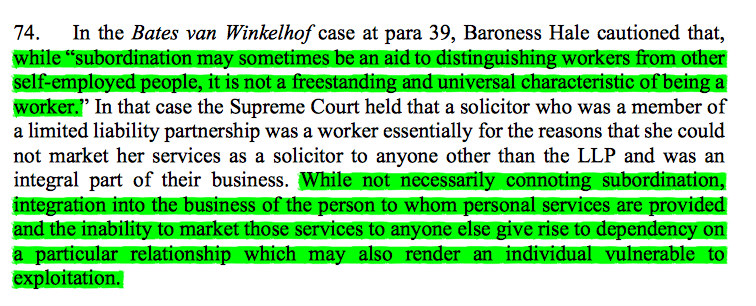
25/ Recognition of that vulnerability showed the folly in adopting an "is there an inconsistency with the written agreement" approach to Autoclenz. That would be to embed the power inequality rather than to recognise its impact. (25 thread limit reached. Ctd below...) 

26/ The Court considered Autoclenz through the vulnerability prism to the facts in Uber, noting the unlikelihood drivers read the Service Agreement & the inability to negotiate its terms. This is our new prism, #ukemplaw-yers. Autoclenz is alive & well & reinvigorated. 
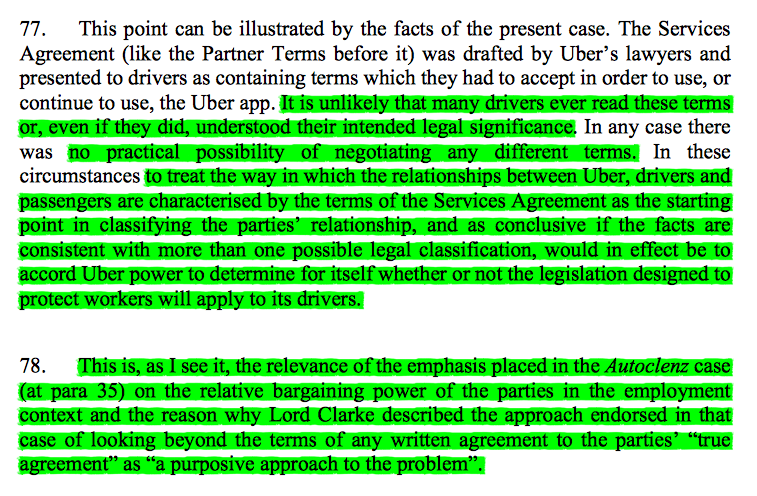
27/ The Court bolstered its approach by noting that the protective provisions relating to workers all prohibit contracting out. The narrow approach to Autoclenz allowed contracting out by the back door (& positively encouraged lawyers to go searching for that back door). 




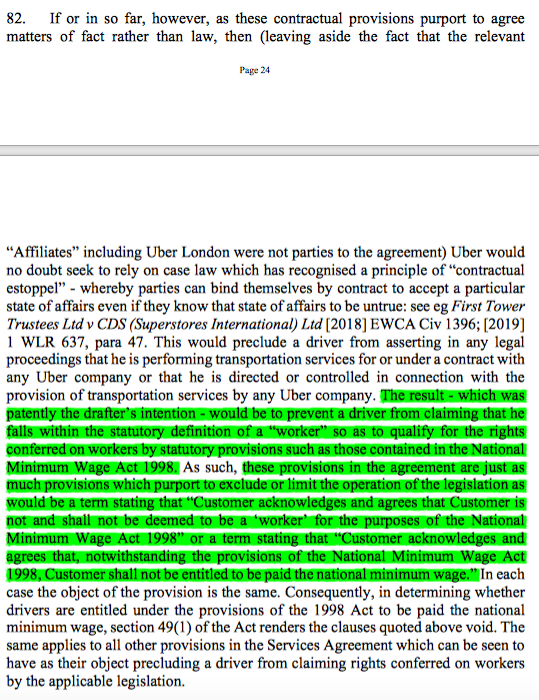
28/ The Court moved on to how to apply the worker definition. Starting with Autoclenz & Carmichael, the Court explained how you don't ignore the written agreement but don't just presume it to be the whole or that signatures confirm it as a true agreement. 
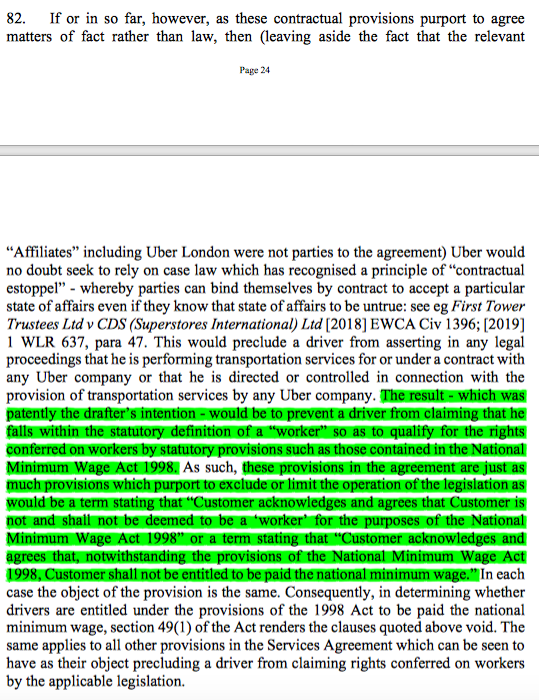
29/ The final point in PARA 85, pasted in tweet 28, is important & deserves double highlighting. Disregard any written clause purporting to classify the legal relationship or to prevent interpretation as a particular legal relationship. IT IS OF NO EFFECT. 

30/ So, what is a worker then? The starting point is the words of the statute, but that has to be read with both the statutory purpose & a realistic approach to the facts in mind. The realistic approach recognises matters of subordination, dependency & degree of control. 

31/ In Uber, it was never suggested that drivers operated under an umbrella contract (i.e. a contract governing the relationship from start to finish providing for obligations at all times irrespective of whether at work).
32/ Rather the contractual position (however it was classified) related to periods when the driver was at work (whatever that meant - see below). That entitled drivers, if workers, to bridge gaps to establish continuity of service necessary to key into various rights. 



33/ The Court offered one small crumb of comfort here to employers, recognising from the Equality Act interpreter case of Windle that intermittent/casual work may be a factor contributing to an indication of independence. 

34/ Here there were 5 particular aspects of the relationship that the Supreme Court wanted to emphasise in particular in supporting their finding of worker status (here's the bit that all #ukemplaw-yers will remember) (it's worth going back to tweet 3 before reading below.
35/ 1st, the lack of any say in remuneration or the service fee, or even on whether a refund should be given. That's a key point of subordination. 

36/ 2nd, the lack of any input by the drivers in the contractual provisions. They're imposed on the drivers, they're required to accept them before being accepted onto the platform, & terms between drivers & passengers are imposed without any say for the driver.
37/ 3rd, constraints over a driver's agency in acceptance of jobs, by (a) Uber having sole control on whether to accept or decline a request for a ride, (b) restricting information including destination, & (c) the penalty system for not accepting jobs offered. 

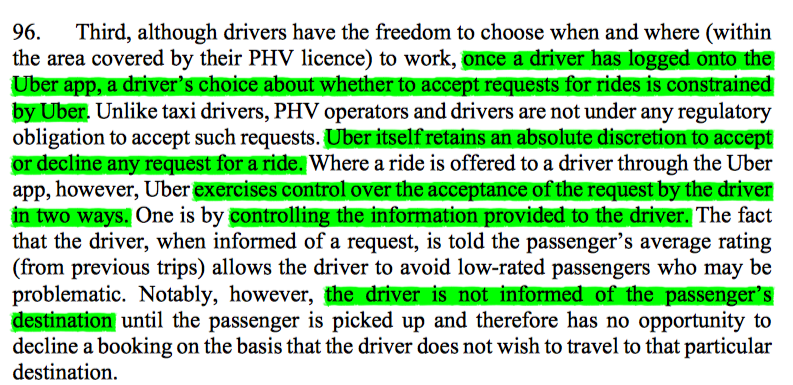

38/ 4th, control over how a driver delivers the service, including vetting the car used, sole ownership over the tech installed, sole control of guiding the driver to the pick-up point & the proposed route to destination & a ratings system used to assess & to remove from Uber. 



39/ Finally, restricting communication between driver & passenger to the minimum necessary, including holding back contact details save for 1st name & prohibiting a driver from contacting a customer after the trip save to return lost property. 
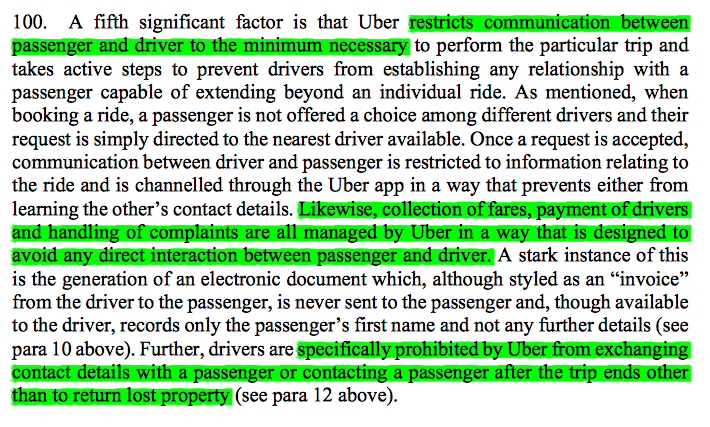
40/ Taken together, these factors show not only the tightness of control, but also how Uber designs the service so that the customer loyalty is to it rather than to drivers, & that drivers are interchangeable pawns in the Uber service delivery model. 
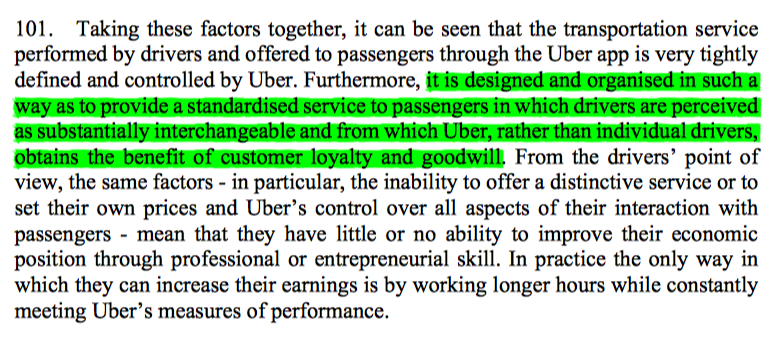
41/ The Supreme Court next moved on to compare the Uber situation with that of accommodation booking agents, a necessary comparison to deal with powerful submissions made on the Secret Hotels2 case. Fundamental differences included who sets the price & distinctiveness of options. 


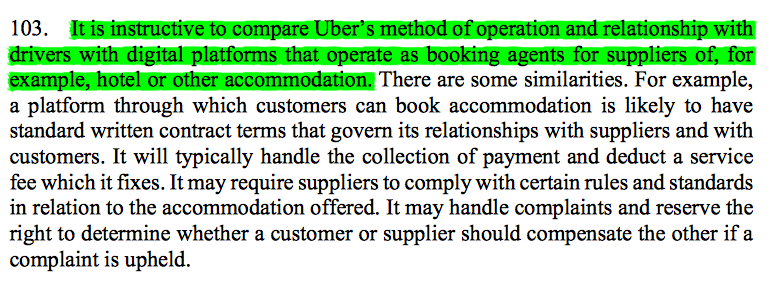

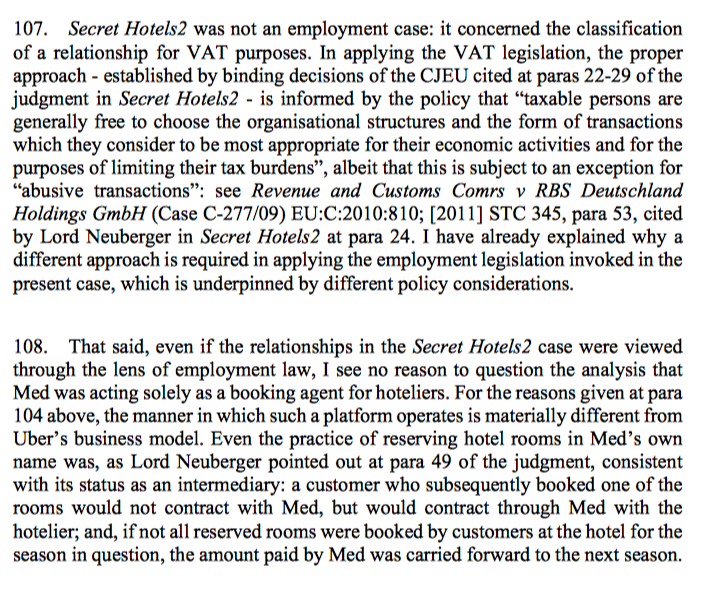
42/ The Court then moved on to comparison with the minicab cases of Mingeley v Pinnock & Khan v Checkers, where the drivers had been found to be independent contractors. The Court was nonplussed with the latter & took a restrictive view of the former. 



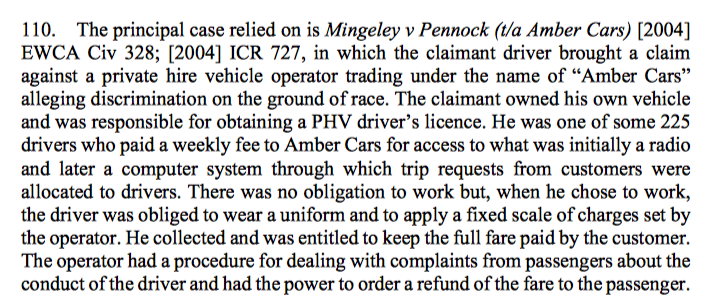
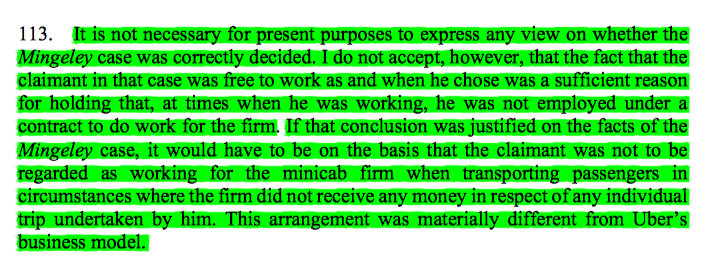

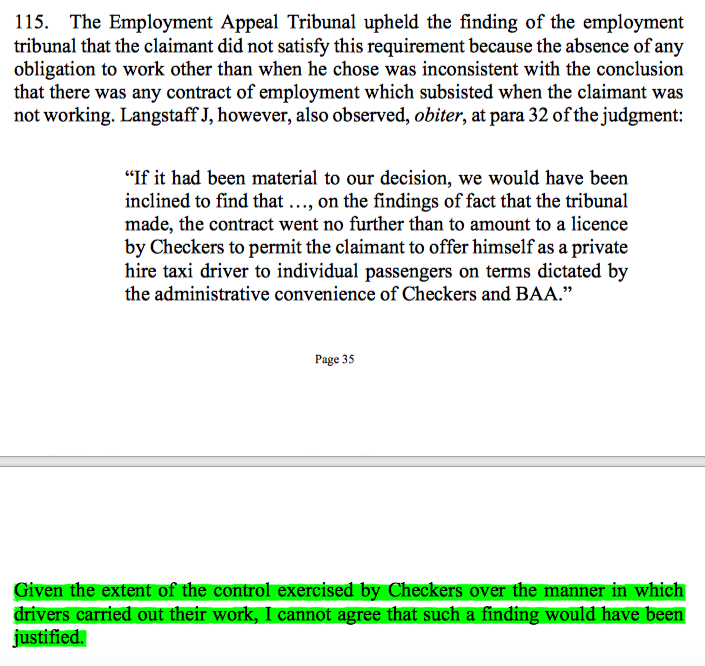
43/ As you can see, those conclusions very much focused on questions of control, identifying whether or not the factual circumstances could be read similarly to the situation of the Uber drivers. In doing so, the Court doubted the relevance of either Cheng Yuen or Quashie to Uber 

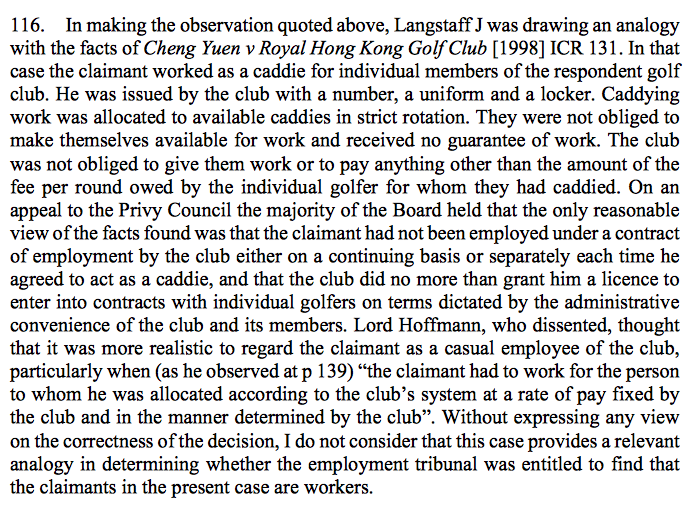
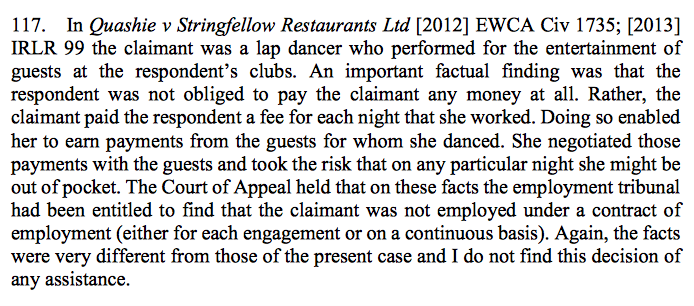
44/ Turning back to Uber, the ET had made appropriate findings of fact without misdirecting on the law. Whilst some of EJ Snelson's comments may (as the CA found) have been misplaced (albeit lots of fun to read!) they didn't detract from the lawfulness of the findings reached. 
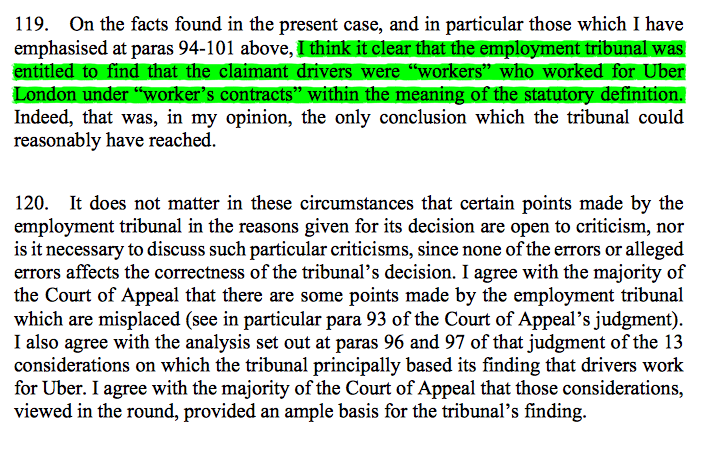
45/ Finally, the Court moved to the working time issue under the Working Time Regs & the National Minimum Wage Regs. During what periods were the drivers entitled to the rights open to them through their newly realised worker status?
46/ It was clear that at the latest, the contract was entered into on accepting a trip, but what about at an earlier point? 
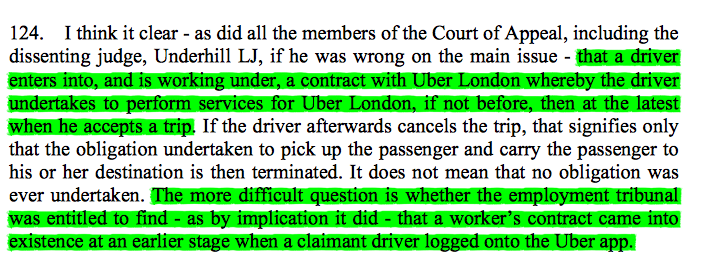
47/ To answer that, the Court needed to identify when there was an 'irreducible minimum of obligation' between the contracting parties. A right to refuse some work wasn't fatal so long as there was an obligation to do some work. 

48/ The Court held that logging on brought a driver within the worker definition. Whilst there were documents supportive of this conclusion, the real key was the ET's findings about the coercive penalty regime for being logged in & not accepting rides. 




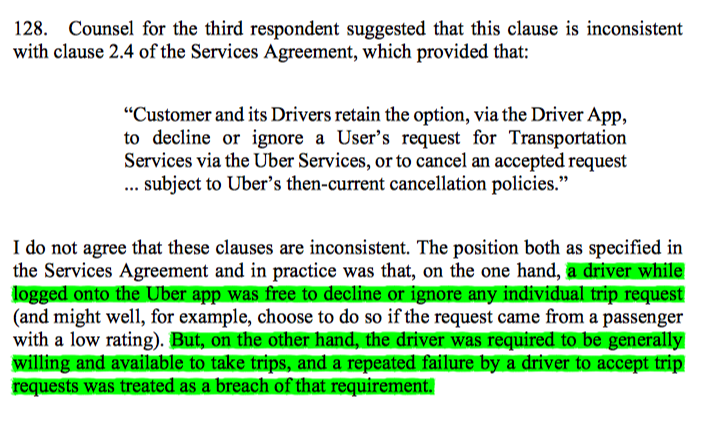
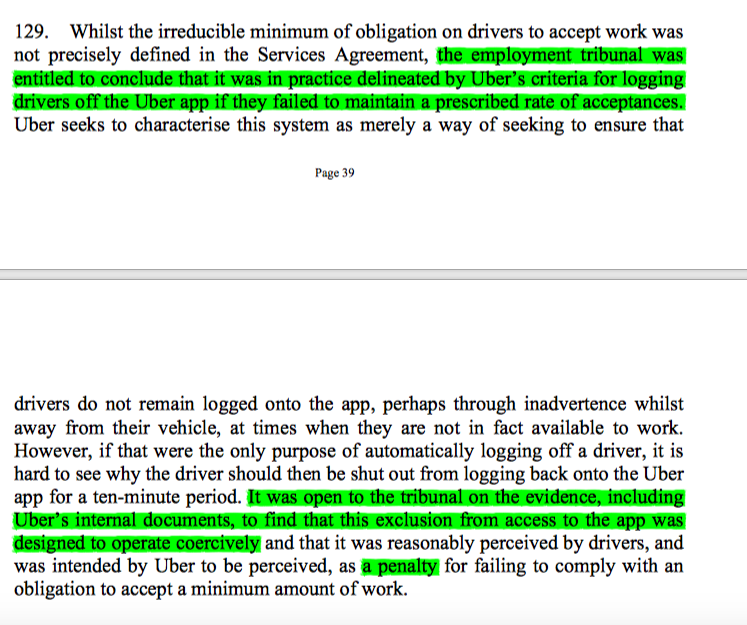

49/ Applying that to the WTR, a driver is engaged in working time when logged on to the App, with 1 possible caveat - if logged on to multiply providers' apps at once & able to hold out as available for them all at once, the driver may not be working for Uber at that point. 


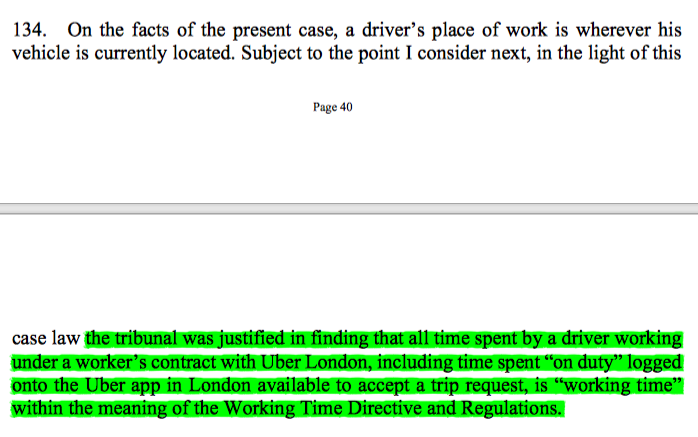


50/ That, alas, is a question not determinable in the abstract, which will doubtless lead to another 5 years of litigation over the compensation due for time logged on but not on a trip. The Court noted though that at the stage of ET proceedings no other such app was in play.
51/ Finally, the Court considered the NMW Regs in a brief paragraph, holding that the ET had been entitled to find the work counted under the residual category of 'unmeasured work' and that the NMW are applicable under that category. I'll leave it to someone else to explain that!
52/ So there we go. A bit of a barnstormer. Finally some semblance of clarity for #ukemplaw-yers on employment status and its application to the #gigeconomy, and a judgment that will be quoted pretty quickly in ETs and appellate courts all over the land.
53/ The Supreme Court added a postscript to confirm Lord Kitchin's ill-health as explaining why the Court's decision is only written by 6 rather than 7 members of the Court. Which also explains @JoshuaRozenberg's observation that Lord Kitchin wasn't listed on any panel this term.
54/ Oh, and by the way, if you've got this far, look to @JeremiasPrassl for his superb analysis & to @thebigbogg likewise, oh and make sure to subscribe to @daniel_barnett's webinar series, which has the victorious @galbraithmarten explaining all on Monday morning! #ukemplaw
• • •
Missing some Tweet in this thread? You can try to
force a refresh










